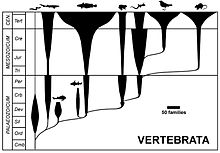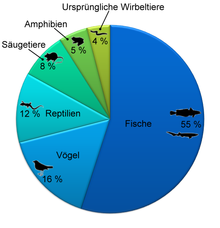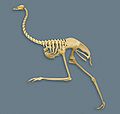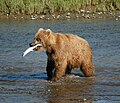Vertebrates
| Vertebrates | ||||||||||||
|---|---|---|---|---|---|---|---|---|---|---|---|---|

Representatives of the five classic groups of vertebrates. |
||||||||||||
| Systematics | ||||||||||||
|
||||||||||||
| Scientific name | ||||||||||||
| Vertebrata | ||||||||||||
| Cuvier , 1812 |
Vertebrates (Vertebrata) are chordates with a spine . This sub-tribe includes five large groups traditionally managed as classes : fish ( bone and cartilaginous fish ), amphibians , reptiles and birds , mammals and, as primitive representatives, the round-mouthed species . They are contrasted with the informal group of invertebrates or invertebrata (all other animals ), which have no spine.
Many zoologists today prefer the term skull animals (craniota) for this taxon . This view takes into account that the round mouths, like some other vertebrates, do not have a spinal column as an axial skeleton , but a notochord . But what all vertebrates have in common is an ossified or cartilaginous skull ; its presence is therefore one of the commonly derived features ( synapomorphies ) of this chorus data group.
Basic plan
The monophyly of vertebrates is a common set of derived (new) Basic plan features ( synapomorphies supported):
- Multi-layered epidermis : The epidermis differentiates itself into several superimposed cell layers. Within the vertebrates, the "skin" is formed with several layers and associated structures such as scales, feathers, etc.
- Neurocranium: The brain and the large sensory organs are protected by a capsule (brain skull ).
- Neural crest : An embryonic structure made up of pluripotent cells that arise from the ectoderm at the border between the epidermal ectoderm and the neural ectoderm. Among other things, they form the skeletal structures of the head, pigment cells, nerve cells such as Rohon-Beard cells, ganglia and odontoblasts .
- Placodes : thickening of the embryonic epidermis. Placode cells are involved in the formation of neural organs.
- Labyrinth organ : the organ of equilibrium
- Brain : The front part of the neural tube is differentiated into a (multi-part) brain.
- Brain nerves : In the basic plan ten nerves of completely different nature, which connect the brain with the periphery. They are fairly constant throughout vertebrates.
- Blood vessel system : The cardiovascular system is an (almost completely) closed system.
- Kidneys : Central urinary organ ( excretion organ) of vertebrates
- Vertebrate eyes : highly developed and complex sensory organ for the perception of optical stimuli
- Spinal ganglia : ganglia can be assigned to the spinal nerves.
Systematics
External system
The vertebrates have the rank of a sub-tribe in the conventional biological system. Together with the tunicates and the species-poor skullless, they form the trunk of the chordates (Chordata).
According to the notochordata-urochordata hypothesis , the vertebrates are considered to be the sister group of the skullless (acranians / cephalochordata), which is why they are often referred to as "skull animals" (craniota or craniata). The alternative, later published Olfactores-Cephalochordata hypothesis , however, states that the tunicates (Urochordata / Tunicata) is the sister group of vertebrates. It is still not clear which hypothesis is correct.
Internal system

In the past, vertebrates were divided according to the criterion of whether or not there was a jaw . This approach is outdated: the jaw- mouths ( jaw animals) are no longer contrasted with the jawless ones (Agnatha), but the round- mouthed ones (cyclostomata ).
The internal systematics of vertebrates, however, remains controversial, especially the question of whether there is a sister group relationship between jaw-mouthers and lampreys or between hagfish and lampreys:
- Hagfish + (jaws + lampreys)
- (Hagfish + lampreys) + jaws
The following illustration also takes into account extinct groups. The classic large groups are highlighted in bold.
Vertebrates (Vertebrata): over 70,300 species
- Round mouths (Cyclostomata) about 131 species
- " Ostracodermi " † ( paraphyletic )
-
Gnathostomes (Gnathostomata): over 70,200 species
- Placodermi † (paraphyletic)
- Acanthodii † (paraphyletic)
- Cartilaginous fish (Chondrichthyes): about 1227 species
-
Bony fish (Osteichthyes) (paraphyletic)
- Radiation fins (Actinopterygii): over 33,400 species
- Meat fin (Sarcopterygii): 8 species
-
Land vertebrates (Tetrapoda): over 35,600 species
- Amphibians (Amphibia): over 7,800 species
-
Amniotes : over 27,800 species
- Sauropsida
- Mammals (Mammalia): about 6,400 species, in addition 96 species became extinct in historical times
Extinct groups
The extinct, often heavily armored, jawless taxa are grouped together as ostracodermi , the armored, jawbearing ones as placodermi . Both groups, however, are not monophyletic taxa, nor are the Acanthodii , some of which are basal to cartilaginous fish or to bony fish.
The affiliation of the extinct conodonts to the vertebrata is disputed.
Distribution and number of species

Vertebrates are common worldwide. They live on all continents including the Antarctic, in the sea to the deep sea, in fresh waters, and on land in all biotopes including the high mountains. Birds and bats have the ability to actively fly, which favors the spread. The biodiversity is highest in the tropical rainforests ( Amazon region , areas in Africa and Southeast Asia ).
Today there are over 70,000 species of vertebrates, more than half of which are fish. It is estimated that this is about one percent of all vertebrate species that have appeared in the course of evolution . The number is significantly higher than stated in older sources, e.g. For example, the IUCN gave 57,739 known vertebrate species for 2004. Hundreds of vertebrate species are discovered every year, around 1246 new mammal species since 1982, around 7407 new fish species since 1996, around 2010 amphibian species since 2004, and around 1716 reptile species since 2008 and up to 2016. In addition, tens of thousands of fossil species have been discovered around the world .
Body sizes
Overall, vertebrates are significantly larger than invertebrates. Most invertebrates are only a few centimeters tall, and the sizes are very often given in millimeters. The only exceptions among the invertebrates are the cephalopods , some crustaceans ( lobsters , lobsters ) and giant clams . Vertebrates a few centimeters in size, on the other hand, always belong to the smallest species of their taxon .
The smallest vertebrates living in water are some gobies (e.g. Schindleria brevipinguis ) and carp fish (e.g. Paedocypris progenetica with a length of 7.9 mm for females and 10 mm for males), the smallest land vertebrate is the frog Paedophryne amauensis ( with a length of 7.7 mm). The Etruscan shrew ( Suncus etruscus ) with a trunk length of 2 cm and a weight of 1 g and the bumblebee bat ( Craseonycteris thonglongyai ) with a weight of 1.5 to 3 g are considered the smallest mammals.
The largest vertebrate is the blue whale ( Balaenoptera musculus ) with a maximum length of 30 meters and a maximum weight of 200 tons. The largest recent vertebrate living on land is the African steppe elephant ( Loxodonta africana ) with a maximum weight of 7 tons. The largest extinct vertebrates on the mainland were the sauropods (Sauropoda), a very species-rich group of dinosaurs.
The prerequisites for this increase in size in vertebrates were their unique inner skeleton , consisting of bones and cartilage , the development of very powerful muscles and the closed cardiovascular system .
Age
Some vertebrates reach an age far beyond that of the higher animals. It has been known for some time that bowhead whales can live for more than 200 years. Recently, a life length of over 270 years has been established for the Greenland Shark, it is considered likely that the animals can even live to be more than 400 years old.
Picture gallery
- Skeletal structure using the example of vertebrates living today
Skeleton of a lamprey , a fish-like vertebrate from the group of the jawless group (Agnatha)
Skeleton of a cartilaginous fish ( chocolate shark )
Skeleton of a bony fish ( carp )
X-ray image of Paedophryne amauensis . This species of frog is the smallest vertebrate with a length of 7.7 mm.
Skeleton of a blue whale , the largest known vertebrate in the history of the earth.
Human skeleton .
Skeletons of two domestic dogs of different sizes ( Great Dane and Chihuahua ).
Skeleton of an emus (ratite)
Skeleton of a snake ( tiger python )
- Not a representative sample of vertebrates
European tree frog ( Hyla arborea )
Head of the river lamprey ( Lampetra fluviatilis )
Rainbow trout ( Oncorhynchus mykiss )
Brown bear ( Ursus arctos ) with prey
Bottlenose dolphin ( Tursiops truncatus )
Herring gull ( Larus argentatus )
See also
literature
- W. Westheide, R. Rieger: Special Zoology. Part 2: vertebrates or skulls. Spectrum Academic Publishing House, 2003, ISBN 3-8274-0900-4 .
- G. Mickoleit: Phylogenetic systematics of vertebrates. Publishing house Dr. Friedrich Pfeil, 2004.
- Joseph S. Nelson : Fishes of the World. John Wiley & Sons, 2006, ISBN 0-471-25031-7 .
Web links
- Genome 10K Project (English). A collection of genetic codes from 10,000 vertebrate species, roughly one genome for each genus
Individual evidence
- ^ Hynek Burda: Systematic Zoology. P. 241/242, Eugen Ulmer Stuttgart, 2008, ISBN 978-3-8252-3119-4 .
- ↑ Order Myxiniformes on Fishbase.org (English)
- ↑ Order Petromyzontiformes on Fishbase.org (English)
- ↑ Order Rajiformes on Fishbase.org (English)
- ↑ Order Torpediniformes on Fishbase.org (English).
- ^ Order Rhinopristiformes on Fishbase.org (English).
- ^ Order Myliobatiformes on Fishbase.org (English).
- ↑ Order Chimaeriformes on Fishbase.org (English).
- ↑ Greta Carrete Vega, John J. Wiens: Why there are so few fish in the sea? In: Proceedings of the Royal Society B: Biological Sciences. 279, 2012, pp. 2323-2329, doi: 10.1098 / rspb.2012.0075 .
- ↑ Number of species (as of 2017) in the Catalog of Fishes .
- ↑ Order Ceratodontiformes on Fishbase.org (English).
- ^ Order Lepidosireniformes on Fishbase.org (English).
- ^ Order Coelacanthiformes on Fishbase.org (English).
- ↑ Number of species in the Amphibiaweb.org database , accessed on January 3, 2018.
- ↑ Testudines in The Reptile Database Squamata in The Reptile Database Rhynchocephalia in The Reptile Database Crocodylia in The Reptile Database Species number (status: 2018).
- ^ IOC World Bird Names (v 3.3). F. Gill, D. Donsker, 2013, accessed April 16, 2013 . .
- ↑ Connor J Burgin, Jocelyn P Colella, Philip L Kahn, Nathan S Upham: How many species of mammals are there? In: Journal of Mammalogy. Vol. 99, No. 1, 2018, doi: 10.1093 / jmammal / gyx147 , pp. 1–14.
- ↑ ASM Mammal Diversity Database. American Society of Mammalogists, 2017, accessed March 12, 2018 . .
- ↑ Jonathan EM Baillie; Hilton-Taylor, Craig; Stuart, SN: 2004 IUCN Red List of threatened species: A Global Species Assessment. (PDF; 3.73 MB) World Conservation Union, 2004, accessed on June 26, 2017 (English). .
- ↑ Don E. Wilson, DeeAnn M. Reeder (Eds.): Mammal Species of the World: A Taxonomic and Geographic Reference . 3. Edition. The Johns Hopkins University Press, Baltimore 2005, ISBN 0-8018-8221-4 (p. Xix, p. Xxv).
- ^ Catalog of Fishes
- ^ Amphibiaweb.org .
- ^ Reptile Database .
- ↑ Wilfried Westheide , Reinhard Rieger : Special Zoology Part 2: Vertebrate or Skull Animals , Spectrum Academic Publishing House , Heidelberg / Berlin 2004.
- ^ EN Rittmeyer, A. Allison, MC Gründler, DK Thompson, CC Austin (2012): Ecological Guild Evolution and the Discovery of the World's Smallest Vertebrate. PLoS ONE 7 (1): e29797. doi: 10.1371 / journal.pone.0029797 .
- ↑ Julius Nielsen ( University of Copenhagen ) et al .: Eye lens radiocarbon reveals centuries of longevity in the Greenland shark (Somniosus microcephalus) . In: Science August 12, 2016 (Vol. 353, Issue 6300), pp 702-704 ( doi: 10.1126 / science.aaf1703 ), Abstract , zeit.de .














